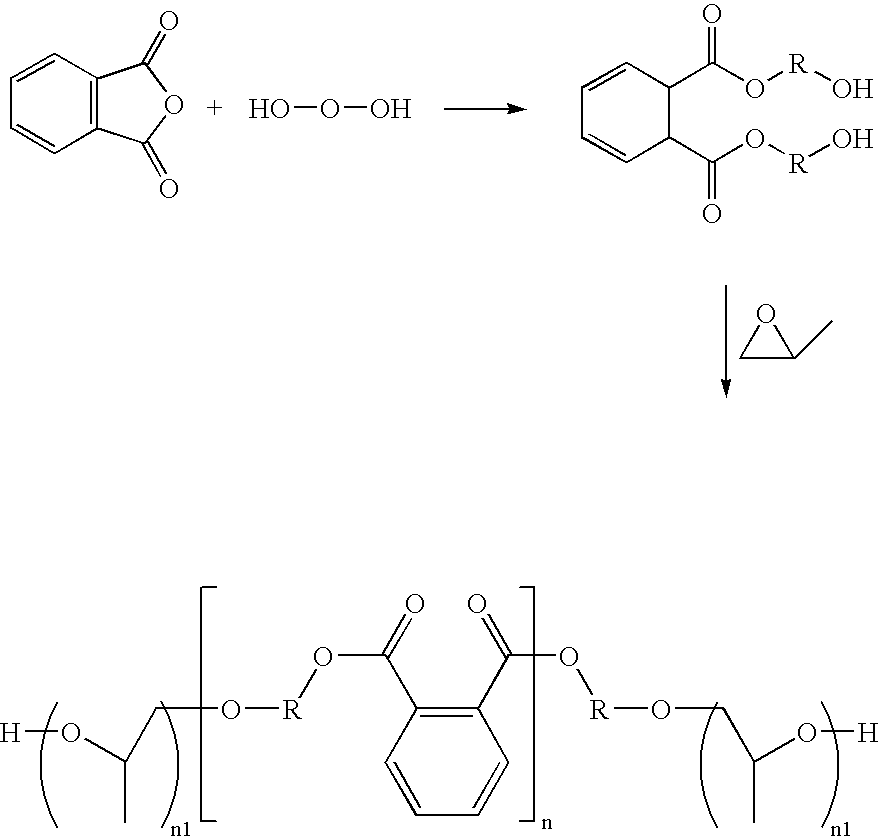Phthalic anhydride based polyester-ether polyols and double metal cyanide catalyst system for preparing same
- Summary
- Abstract
- Description
- Claims
- Application Information
AI Technical Summary
Benefits of technology
Problems solved by technology
Method used
Image
Examples
example 1
Preparation of Polyester Polyol C (Comparative Example; STEPANPOL® PS-2002)
PS-2002 is prepared as the condensation product of about 45% diethylene glycol (DEG) and 55% phthalic anhydride. Into a three gallon kettle is charged 4500 g of DEG and 5500 g PA. This mixture is heated to about 180° C. for four hours under a nitrogen atmosphere. After four hours the temperature is raised to about 180-200° C., and approximately 500 ppm of catalyst tetrabutyl titnate (Tyzor TBT, DuPont) is added to the kettle. The pressure is reduced in the kettle and removal the water by-product is begun under vacuum. The water is completely removed after about 24 hours of reaction at about 180-200° C. under vacuum. The final polyester polyol is characterized by a hydroxyl number of 190-200 mg KOH / g and has a Brookfield viscosity of about 20,000-30,000 cPs at 25° C. and an acid value less than 1 mg KOH / g.
example 2
Preparation of Polyester-Ether Polyol D (Propoxylated Ortho-phthalate Diethylene Glycol Ester)
Into a two gallon steel pressure Chemineer kettle is charged 3678 grams StepanPol® PS-2002 and 155 grams of crushed potassium hydroxide. The mixture is blended under a nitrogen blanket for 2 hours at 120° C. A total of 7,060 grams of propylene oxide is added under a pressure of <42 psig over three hours at a temperature of about 120-125° C. A total of 500 grams of this crude product is then transferred to a flask where it is then heated to about 100° C. and degassed to remove unreacted propylene oxide. The material is then finished / neutralized: To the remaining warm mixture, 1.5 grams of Magnesol HMR-LS (The Dallas Group) is added and the mixture is then stirred at about 100-120° C. for four hours. The resulting mixture is allowed to stand warm (80° C.) for approximately 12 hours and the product is decanted and filtered through a vacuum flask equipped with a Buchner funnel and a #4 Wha...
example 3
Preparation of Polyester-Ether Polyol E (Propoxylated Ortho-phthalate Diethylene Glycol Esters
Polyol E is prepared in a similar manner to that of polyol D, except the amounts of materials used are 14.5 g KOH, 2890 g, StepanPol PS2002 and 6010 g propylene oxide. Analysis of polyol E gave the following properties:
OH value =59.4 mg KOH / g (ASTM E 222 method)Dynamic viscosity =1,400 cp @ 25° C. (Brookfield, #31 spindle)% Propylene oxide =69% by weight% Moisture =0.023% (ASTM D 4672 method)
PUM
| Property | Measurement | Unit |
|---|---|---|
| Fraction | aaaaa | aaaaa |
| Percent by mass | aaaaa | aaaaa |
| Percent by mass | aaaaa | aaaaa |
Abstract
Description
Claims
Application Information
 Login to View More
Login to View More - Generate Ideas
- Intellectual Property
- Life Sciences
- Materials
- Tech Scout
- Unparalleled Data Quality
- Higher Quality Content
- 60% Fewer Hallucinations
Browse by: Latest US Patents, China's latest patents, Technical Efficacy Thesaurus, Application Domain, Technology Topic, Popular Technical Reports.
© 2025 PatSnap. All rights reserved.Legal|Privacy policy|Modern Slavery Act Transparency Statement|Sitemap|About US| Contact US: help@patsnap.com



